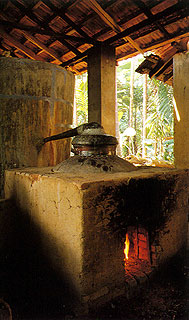


Cinnamon owes its distinctive, spicy fragrance to a volatile oil that it contains. Cinnamon oil is distilled in copper stills from off-grade bark, leaves and roots. The distilleries, always located close to plantations, have a very pleasant effect on the surroundings, scenting the air with a sweet and spicy perfume.
Cinnamon is primarily an edible spice used to enhance and flavor foods. Before the advent of modern food preservation technology, it was, with pepper, the most popular spice for flavoring the salted meat Europeans subsisted on through their long winters. In its native Asian habitats, cinnamon was a much-used spice, along with half a dozen others. However, flavoring food was not cinnamon's only use. In ancient Egypt it was an essential ingredient in embalming the dead, to last for millenniums. In Palestine cinnamon was used for rites of the Tabernacle. And in medieval Europe cinnamon was always added to the incense burnt in churches and was also used in witchcraft.
It was cinnamon which lured explorers such as Vasco da Gama round the storm-tossed Cape of Good Hope in search of a new spice route to the cinnamon lands of the East, when the Ottoman Turks closed Constantinople to trade in 1453. Sailing westwards on the same quest, Columbus made his windfall discovery of America. Cinnamon was the "rich bride Helen" for whom, as one Dutch historian recorded, "the Netherlanders and Portuguese had for so many years contended." It was precious enough to these colonial powers to wage bitter and frequent wars, the very stuff on which their empires were built. Thc Dutch made cinnamon a state monopoly in 1656 in the Dutch-ruled coastal provinces of Sri Lanka; breaches of the Dutch laws relating to cinnamon were even punishable by death. Continued...
